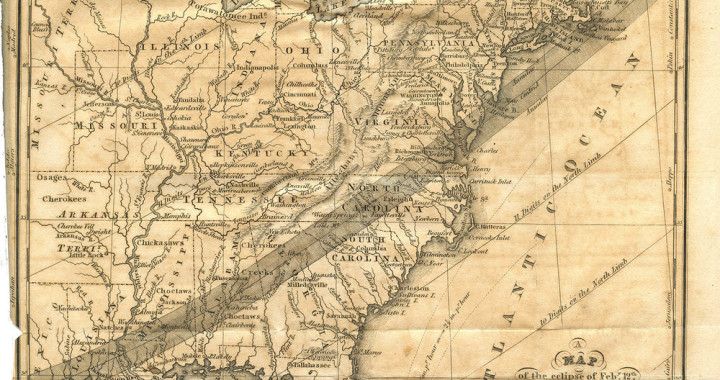Path of 1831 annular solar eclipse seen by Nat Turner. NASA, collection of Michael Zeiler.
Since ancient times we’ve viewed solar eclipses with foreboding. But they don’t affect our lives, do they?
The most significant solar eclipse in American history happened in 1831. What made it important was a man who saw it.
Nat Turner, a slave in Southampton County, Virginia.
Turner was a keenly intelligent and deeply religious man—a minister who believed he had been anointed by God as a prophet “intended for some great purpose” for his people.
Describing a “vision” in 1828, Turner said he “heard a loud noise in the heavens, and the Spirit instantly appeared to me and said the Serpent was loosened and Christ had laid down the yoke he had borne for the sins of men, and that I should take it on and fight against the Serpent…And by signs in the heavens that it would make known to me when I should commence the great work…I should arise and prepare myself and slay my enemies with their own weapons….”
On February 12, 1831, a solar eclipse—viewed by a wide swath of the eastern United States—was the sign in the heavens Turner was awaiting.
He revealed his plot to slaves he most trusted. The uprising was set for July 4.
Turner fell ill and the planned date was delayed. But a few weeks later, Turner launched the bloodiest slave insurrection in American history.
Pillaging plantation to plantation, using farm implements and knives—Turner himself was armed with a broadsword—the rebels killed some 57 of their oppressors, men, women, and children. The next day the uprising was broken up by militia and its leaders scattered.
Retribution was brutal. Perpetrators were captured and hanged. Hundreds of innocent slaves were murdered. Turner was executed and flayed, his skin stitched into a satchel.
The result of Turner’s rebellion was the cruel yoke of slavery being made even grimmer. Virginia’s legislature passed statutes making it illegal to teach a slave to read or to give a slave a book. After the insurrection, it was illegal for slaves to congregate for religious meetings without the presence of a white minister.
The moon blotted the face of the sun in 1831, and though the eclipse passed, a shadow remained.
It would result in the bloodiest war in American history. The rise of nearly a century of Jim Crow legislation. A 20th century movement for equal human rights under the law. And now, as seen in Charlottesville, a renaissance of white supremacy groups venomous with hate.
What makes this year’s solar eclipse especially eerie is it happens on August 21, the date of Nat Turner’s Rebellion.
Maybe Americans can use the weird light of this event to see who and where we really are.
